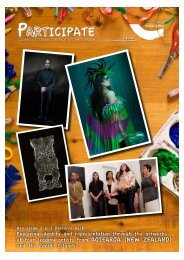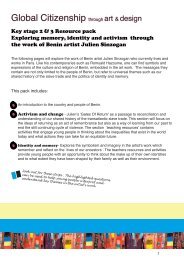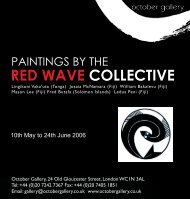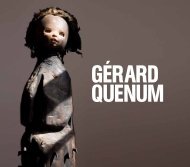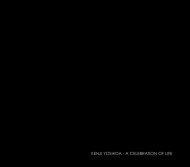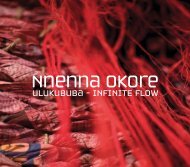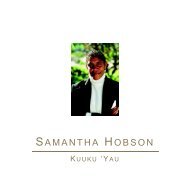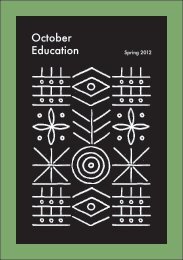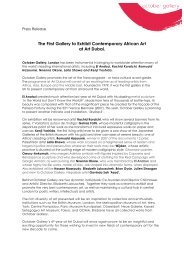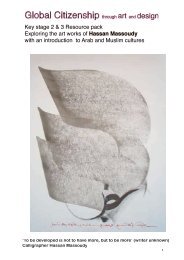Create successful ePaper yourself
Turn your PDF publications into a flip-book with our unique Google optimized e-Paper software.
<strong>Nnenna</strong> <strong>Okore</strong> and her work....<br />
Artists Biography<br />
<strong>Nnenna</strong> was born in Nigeria and currently lives in the USA where she lectures in Art at North Park University, Chicago.<br />
She received her BA degree in Painting from the University of Nigeria (First Class Honors) in 1999, and an MA and<br />
MFA. in Sculpture from the University of Iowa in 2004 and 2005. She has received several awards and residencies<br />
worldwide, and been shown in numerous prestigious galleries and museums within and outside the United States.<br />
Current work<br />
“Currently, I am invested in forms that explore, or are inspired by intimate spaces, shelters, architectural and natural<br />
environments, and ideas related to textures, colors, qualities and social values associated with African fabrics, using<br />
multiples and repetitive processes” <strong>Nnenna</strong> <strong>Okore</strong><br />
<strong>Nnenna</strong> <strong>Okore</strong>’s Inspiration<br />
Much of <strong>Nnenna</strong>’s work is inspired by rural life and her child hood years in Nsukka, a small university town in Southern<br />
Eastern Nigeria. Her work connects to memories of the natural landscape, discarded objects, dilapidated buildings,<br />
nests and shelters.<br />
“As a child, I was fascinated by the social, natural, and artificial* conditions in rural dwellings around the University<br />
campus. Embedded within its landscape were evocative imageries captured within its rocky slopes, and architectural<br />
structures. I came across several stunning traditional art and architectural forms, such as, roofed shrines<br />
characterized by huge mounds of sand under a thatched structure, and yam barns and fences that traced the borders<br />
of people’s compounds” <strong>Nnenna</strong> <strong>Okore</strong><br />
*Artificial: materials produced or formed or made by humans that do not result from natural processes.<br />
Materials in her work<br />
<strong>Nnenna</strong> was inspired by all aspects of rural life, in particular the culture and innovation of reusing discarded objects,<br />
seeing all materials as precious commodities. Living in America has made her reflect on the way societies regard and<br />
value their materials and resources and also the impact of consumerism on our natural environment.<br />
When she moved to America she was surprised at the abundance of materials, how much people consume and how<br />
much of it is just thrown away. Even though there is a huge recycling industry in America, she felt that it was seen in a<br />
different light to how is it used and understood by people in Nigerian society.<br />
“In Nigeria people may use them in other ways such as using paper to wrap foods or a table cloth, old can as lamp<br />
shades - children would make toys out of plastics, you are very aware of the recycling culture out there.......<br />
“ .....Reclaiming recycled materials became a huge part of my work- Reclaiming, reforming, reconditioning,<br />
reconstructing what was no longer considered useful. I was trying to find meaning to them, to find ways to give them<br />
value” <strong>Nnenna</strong> <strong>Okore</strong><br />
She uses a variety of discarded and found materials, in particular paper, such as newspapers, magazines and old<br />
phone books. In her work she transform them into shields, baggages made from plastic bags or a rope made from<br />
paper.<br />
As well as discarded or found materials she uses clay:<br />
“I came into contact with clay for the first time in my<br />
little community in Nsukka, where the landscape<br />
has a lot of clay deposits and so I would often play<br />
with the sand – it was a material that the locals were<br />
very connected to. I appreciate clay because of the<br />
connection I had with it growing up in Nsukka”<br />
<strong>Nnenna</strong> <strong>Okore</strong><br />
sheild me, paper 2008<br />
rope 2006<br />
5



